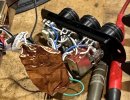fractalman
Member
Hello. I have a “one-off” guitar which has two humbuckers and piezos in the bridge/saddle. It has a push/pull knob to engage an onboard preamp which I’ve always used in the “on” position when using the humbuckers. It sounds great. I created all my FM9 Presets around it being “on.” Now the preamp is starting to fail, and the easiest thing would be to just stop using it – putting the push/pull in the “off” position” – permanently. I never use the piezos, anyway. It’s not that I don’t want to replace the preamp. It’s that the guitar maker is nowhere to be found and I have no way of finding out what this preamp is – assuming I could ever find the exact replacement.
While the preamp is still working (though intermittently), I’ve recorded my guitar with the preamp on and off and done an EQ match in both Logic Pro X and using Izotope. I spent 2 days trying to adjust presets to match the “preamp off” sound to the “preamp on” sound, by ear, and I can only get somewhat close. I’ve tried “boosts” in the amp block – just about everything. Is there a way to measure the “preamp on” signal compared to the “preamp off” signal in a more scientific way? If I could identify the exact value it would make changing all these presets so much easier!! Thanks.
While the preamp is still working (though intermittently), I’ve recorded my guitar with the preamp on and off and done an EQ match in both Logic Pro X and using Izotope. I spent 2 days trying to adjust presets to match the “preamp off” sound to the “preamp on” sound, by ear, and I can only get somewhat close. I’ve tried “boosts” in the amp block – just about everything. Is there a way to measure the “preamp on” signal compared to the “preamp off” signal in a more scientific way? If I could identify the exact value it would make changing all these presets so much easier!! Thanks.

